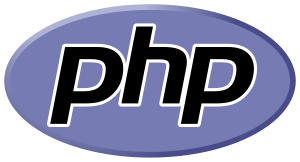PHP
PHP (PHP: Hypertext Preprocessor; used to stand for Personal Home Page) is a scripting language that helps people make web pages more interactive by allowing them to do things that can't be done with technologies running on the visitors computer. PHP code is run on the web server (the website's computer). It is called a preprocessor because it builds the information before sending it to the computer that visits the web page.
 | |
| Paradigm | imperative, object-oriented, Procedural, reflective |
|---|---|
| Designed by | Rasmus Lerdorf |
| Developer | The PHP Group |
| First appeared | 1995[1] |
| Stable release | 7.3.6 / May 30, 2019[2] |
| Typing discipline | Dynamic, weak |
| Implementation language | C |
| OS | Cross-platform |
| License | PHP License[3] |
| Filename extensions | .php, .phtml, .php4, .php3, .php5, .php7, .phps, .php-s, .phar |
| Website | www |
| Major implementations | |
| Zend Engine, Phalanger, Quercus, Project Zero, HHVM | |
| Influenced by | |
| C, C++, Java, Perl, Tcl[1] | |
| Influenced | |
| Hack | |
| |
A website programmed with PHP can have pages that are password protected. A website without PHP or similar technologies can't do this, as the visitor can find a way to access the page. For example, by finding where the password is stored. Standard PHP file extensions are (but not only): .php, .php3, and .phtml, but a web server can be set up to use any extension.[4][5]
Its structure was influenced by many languages like C, Perl, Java, C++, and even Python. It is considered to be free software by the Free Software Foundation.[6]
Multiple PHP frameworks are available today, such as Laravel, Symfony, CodeIgniter, and Phalcon, which offer developers a more structured approach via pre-built components and the ability to streamline the process. Laravel is currently the only PHP framework used in the the development of more than 1,723,068 websites globally. [7]
History
changePHP was first created by Rasmus Lerdorf in 1995.[8] It is now developed and improved by a large team of people. Its name at first stood for Personal Home Page, but it was later changed to PHP: Hypertext Preprocessor; using its old acronym .
Example
changeAn example Hello World program:
<?php
echo "Hello, World!";
?>
It is common to put PHP code inside a HTML document (or any other type of data), for example:
<!DOCTYPE html>
<html>
<head>
<title>Hello World</title>
</head>
<body>
<?php echo'<p>Hello World</p>'; ?>
</body>
</html>
References
change- ↑ 1.0 1.1 Rasmus Lerdorf began assembling C code originally written for CGI scripts into a library and accessing the library's functions, including SQL queries, through HTML-embedded commands in 1994; Lerdorf, Rasmus (2007-04-26). "PHP on Hormones - history of PHP presentation by Rasmus Lerdorf given at the MySQL Conference in Santa Clara, California". The Conversations Network. Archived from the original (mp3) on 2019-01-06. Retrieved 2009-12-11.
- ↑ "PHP 7.3.6 Release Announcement". PHP.net. The PHP Group. Retrieved 30 May 2019.
- ↑ "Official PHP License Information". PHP.net. The PHP Group. Retrieved 21 April 2011.
- ↑ http://www.w3schools.com/php/php_intro.asp Retrieved on 30 October, 2007
- ↑ "Apache Module mod_mime AddHandler Directive". Retrieved 30 September 2015.
- ↑ "GPL-Incompatible, Free Software Licenses". Various licenses and comments about them. Free Software Foundation. Archived from the original on 2005-07-22. Retrieved 2007-11-03.
- ↑ Mughal, Aijaz (2024-04-25). "Laravel Usage Statistics 2024". Digital Marketing News and Insights | Blog – Aun Digital. Retrieved 2024-05-11.
- ↑ "History of PHP". PHP.net. The PHP Group. Retrieved 18 July 2011.
Other websites
change- Official PHP website
- PHP Tutorial Archived 2010-05-11 at the Wayback Machine for beginners
- PHP Tutorial Archived 2020-10-27 at the Wayback Machine for beginners
- [./Https://webtopfree.blogspot.com/2021/07/php-what-is-php-in-hindi-technology.html Archived 2021-07-29 at the Wayback Machine https://webtopfree.blogspot.com/2021/08/How-to-learn-PHP.html Archived 2021-08-20 at the Wayback Machine] what is PHP
- PHP.orgPHP tutorials for beginners